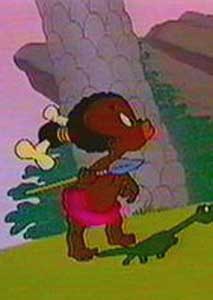Race Stereotypes in Animation Part III:
Chuck Jones's "Inki"
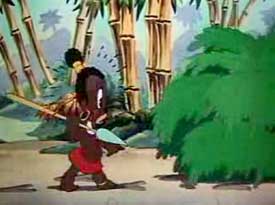 The African pygmy child Inki only got his name with his second cartoon. He is nameless in The Little Lion Hunter (1939). It's an unusually pretty cartoon, opening with a South American macaw in gorgeous flight, a feasting giraff, & a butterfly, each in turn threatened by spear-chucking Inki.
The African pygmy child Inki only got his name with his second cartoon. He is nameless in The Little Lion Hunter (1939). It's an unusually pretty cartoon, opening with a South American macaw in gorgeous flight, a feasting giraff, & a butterfly, each in turn threatened by spear-chucking Inki.
Though the character design is fully set in all but having a name, it is interesting he does not yet have the bone through his topknot, an addition that weakened the character for the last couple episodes by reducing him to even more of a stereotype.
In this pilot outing he's definitely a cute little guy with his odd predilection for tossing his spear at insects & his association with the lion & with the mysterious hopping mynah bird. He has as much character as he will ever have, which isn't much, ineptitude as a hunter & general cuteness being his main trait. Even a turtle with a few moments in this adventure is too swift & clever for Inki.
Most of the only moderately amusing gags will be repeated in every Inki cartoon without much variety. He tries to spear the minah bird (the cartoonists had been spelling it mina & minah, & it was never corrected to mynah).
Inki is a lousy shot & never hits anything. rushes about to get away from the lion that he has no chance of hunting, until the lion is defeated by the improbably mighty minah bird. And the minah bird is kind of pointlessly meanspirited, seeming to have "saved" Inki from the lion, but then rebuff's Inki's friendsip & kicks him in the butt.
Because all of Inki's adventures are without dialogue, it can be understood even by the tiniest tots without much vocabulary, & they had "international" potential for the exportation of a stereotype.
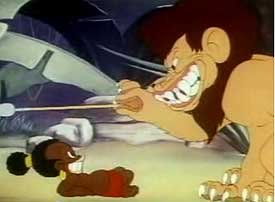 Inki, still without the bone through his topknot, but now having a name in his second film Inki & the Lion (1941), is the same ol' incompetent spearchucker following the hopping minah bird, who is lackadaisical but does ferocious things off-camera.
Inki, still without the bone through his topknot, but now having a name in his second film Inki & the Lion (1941), is the same ol' incompetent spearchucker following the hopping minah bird, who is lackadaisical but does ferocious things off-camera.
The gag from the first Inki adventure of reaching in a hole to get the minah, & grabbing a skunk instead, is repeated, as this series had a definate problem coming up with anything original & repeated its gags a lot.
When Inki tries to kill a cute little lion cub he pretty much sets himself up as a dumb little shit if not a villain. The big male lion from the first film protects the cub & a series of gags about Inki & the lion procede without much wit or charm.
The lion of later episodes will have more cuteness & personality; this lion has a semi-realism without cuteness.
As stereotyped race characters go, Inki isn't the worst, & would probably be especially liked by very small children because of his industrious childlike if failing efforts. And being saved then bullied by the minah bird probably works as both tot humor & tot suspense.
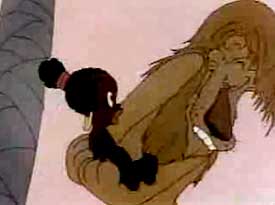 Inki, a child of a never-seen African tribe, goes through his paces in a third cartoon Inki & the Minah Bird (1942), recycling gags from the first two outings.
Inki, a child of a never-seen African tribe, goes through his paces in a third cartoon Inki & the Minah Bird (1942), recycling gags from the first two outings.
He starts out trying to spear a caterpillar then a butterfly, & is pretty spooked when the butterfly roars at him.
Finally the terror of the jungle shows up, a slow-moving black minah bird that hops to "Fengal's Cave Overture" by Mendelson, a weird but one-note character who somewhat resembles a pokerfaced version of the manic Dodo Bird from Porky in Wackiland (1939) & Dough for the Dodo (1949).
The bulk of the cartoon is spear-chuckin' Inki failing to be much of a hunter, outwitted by the minah bird.
At one point a ferocious lion goes after the minah bird & the bird fools & defeats this king of the jungle, too.
The lion is "cuted up" compared to the first two films. He has more personality than Inki, as Inki never does much of anything to rise above his stereotypical nature. And while Inki is undeniably a cute character, he does play into the "spearchucker" stereotype exclusively & is given no depth.
 Inki was never a very deeply developed character, though his ineptitude was supposed to make him vulnerable rather than an idiot. With his big white lips & with bone through his hair for the last two films, he's an increasingly offending caricature of an African child, hardly more than Tar Baby or Little Black Sambo.
Inki was never a very deeply developed character, though his ineptitude was supposed to make him vulnerable rather than an idiot. With his big white lips & with bone through his hair for the last two films, he's an increasingly offending caricature of an African child, hardly more than Tar Baby or Little Black Sambo.
If this caricature hadn't already been done & done to death in endless numbers of children's books & comic strips before he reached animation studios, he might seem a lot cuter. But nothing about him is new, & it is easy to see he'll grow up to be one of those endlessly skittish & incompetent negro males that Hollywood loved to perpetuate.
For Inki at the Circus (1947), with absolutely no sense of irony, Inki seems to be owned by the circus as a slave. He's kept in a cage with signs warning that he's a dangerous wild man of Africa.
He stands against the back wall of his cage, looking sad, playing idly with a yoyo, having been deprived of his spear as well as his freedom.
A dog supplants the usually-encountered lion, though you'd think the lion could've been in the circus too. The dog is interested in getting that bone through Inki's topknot, & enters the cage to sit next to him, playing innocent while periodically snapping at the bone.
He grabs the bone, carries it away with Inki dangling from it, & buries the bone out on the circus grounds, Inki left standing on his head.
A scottish terrier with a kilt digs up the bone & the two dogs have a gag-filled battle over who gets the bone, Inki dangling the whole while.
But then a high-security package arrives at the circus containing the most ferocious animal that ever was. The steel crate is burst open from the inside, & out hops the minah bird.
The bird ties the two dogs' noses together thus saving Inki, not that they were bad dogs; Inki should've been more capable of helping himself out of that jam, but he's never shown to have any of a child's expected cleverness about anything.
Appreciative Inki tries to shake hands (or wing) to thank the minah bird, but the expressionless bird is actually kind of a mean shit, & spins Inki's topknot bone like a helicopter. This bird is never friends with anyone.
Chase scenes take Inki & the two dogs & the cruel minah bird onto a highwire & then a trapeze & through other settings at the circus, which is apparently not open for business as there are no people present, no clowns or acts.
The great setting is not used well, & ultimately it's a pretty mediocre cartoon, which ends with the minah bird getting the bone.
 In the days of the dinosaurs & the mammoths, which existed simultaneously with sabortooth tigers & pterodactyls, Caveman Inki (1950) is pretty brave merely to walk outside his cave.
In the days of the dinosaurs & the mammoths, which existed simultaneously with sabortooth tigers & pterodactyls, Caveman Inki (1950) is pretty brave merely to walk outside his cave.
He has a pet baby dinosaur which functions as a hunting hound. Inki follows along behind his little dogosaurus with a spear.
This is Inki's fifth & last cartoon appearance, & despite a novel setting, he's the same old incompetent kid. One good thing you can say about it, though, is the film acknowledges that prehistoric man was black, not white.
We find Inki again trying to hunt insects & tiny beasts & pretty much failing as a hunter. Then a mountain splits open & out of its heart hops the terror of prehistory, the minah bird who hops to a slow tune by Mendelson.
More or less the same cutsie lion we saw in Inki & the Minah Bird is also back there in prehistory, though he's a lot smaller this time, being a cub (albeit with adult mane developed). He sees Inki stalking the minah bird & has a sudden hankering for that bone through Inki's topknot.
The lion cub with dog-like personality leaves his mommy's pride of baby lions to get Inki's bone. It'll be the best gag in the film, such as it is.
Also repeated is the lame gag of the Minah bird pursued through a series of holes in the ground. For climax, a killer brontosaur takes out after Inki & the lion cub, but is interupted by the minah bird, & is defeated by the unexpectedly mighty bird.
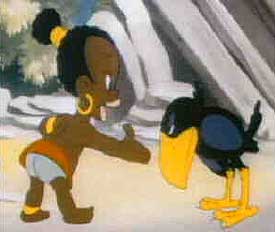 In summation for the five Inki cartoons, he's not the worst stereotype & comes off more like a cartoon child than anything else. His incompetence as a hunter means he doesn't really kill things, so is defacto a sweet fellow despite his efforts to kill infant animals & butterflies.
In summation for the five Inki cartoons, he's not the worst stereotype & comes off more like a cartoon child than anything else. His incompetence as a hunter means he doesn't really kill things, so is defacto a sweet fellow despite his efforts to kill infant animals & butterflies.
Inki's close enough to a baby Sambo that he's scarcely praiseworthy, but he's not horrendous either. He's at the very least never seen with cannibal cookpots; & his facial characteristics aren't too bad since he is a cute little fellow unlike the horrific caricatures of nearly all tribal Africans encountered in other cartoons; & really only the bone through the hair, not originally part of his design, seems truly unnecessary.
These films remain withheld from television broadcast out of sensitivity toward black folk who might be offended. If this were as offensive as cartoons got, there'd be nothing much at all to complain about, but Inki is alas just the first "endearing" step toward the more overt racism of other caricatures, not a departure from it.
Chuck Jones admitted he never understood either Inki or the minah bird; & this lack of comprehension is certainly evident for Inki who has few traits & never waivers from them. The character had not begun as his own & he never embraced the little guy.
Inki without a name was drawn as early as 1930 in the notebooks of Charlie Thorson, but no animated project got off the ground until after Thorson left Warner Brother. And it's doubtful the creator understood the character either.
Thorson claimed to have designed Inki as "the fraternal twin" of a saccharine Indian child he'd designed earlier when working for Disney (for the Silly Symphony Little Hiawatha, 1937). And though in fact he may have drawn his African child before he ever drew the Indian child, Inki was even so never his own character even his creator's mind.
Chuck Jones otherwise oversaw Inki from beginning to end. He was never pressured to stop making these cartoons; he just didn't enjoy them himself.
Yet the timing of Inki's discontinuance cannot be entirely "coincidental" to Civil Rights intellectuals who had finally convinced nearly all the cartoon studios at this time to stop doing blackface minstrel show caricatures & bone-through-nose or bone-through-hair Africans. This change which meant, alas, not that black cartoon characters became richer & better, but that they disappeared entirely.
copyright © by Paghat the Ratgirl
|
